WiMAX Forum announced that February 1st, 2012, Ronald Resnick will retire from his role as the President of the WiMAX Forum.
“Mr. Resnick has been a valued part of the WiMAX leadership for the past eight years,” said Dr. Mohammad Shakouri, Interim Chairperson of the WiMAX Forum. “The WiMAX Forum would like to thank Mr. Resnick for building a strong foundation for this organization, which will continue its work in standardizing and certifying technology to bring broadband to underserved markets across the world. We all wish Mr. Resnick the best of luck in his future endeavors.”
 The WiMAX Forum also announced that Declan Byrne has been unanimously elected as Acting President of the WiMAX Forum. Declan Byrne joined the WiMAX Forum in 2010 as the Senior Director of Marketing. Prior to joining the WiMAX Forum, Byrne worked for Airspan as Chief Marketing Officer.
The WiMAX Forum also announced that Declan Byrne has been unanimously elected as Acting President of the WiMAX Forum. Declan Byrne joined the WiMAX Forum in 2010 as the Senior Director of Marketing. Prior to joining the WiMAX Forum, Byrne worked for Airspan as Chief Marketing Officer.
The WiMAX Forum performs a similar function as the WiFi Alliance; it promotes the use of the technology and tests compatibility. WiMAX Forum-certified gear is tested to for compatibility to the standard, so for example, a Samsung WiMAX basestation will work with a Huawei WiMAX client.
The IEEE develops communications standards. They include IEEE 802.16 (WiMAX), which the WiMAX Forum promotes and enforces, and IEEE 802.11 (WiFi), which the WiFi Alliance promotes and enforces.
Last week the International Telecommunication Union (ITU) approved the “WirelessMAN-Advanced” as part of IMT-Advanced world-wide 4G technology standard. WirelessMAN-Advanced is based on the IEEE 802.16m. The WiMAX Forum calls it WiMax 2.0 (pdf)
Key features of WiMAX 2.0 include:
- Radio specification for FDD and TDD
- Support of IMT-A frequency bands
- At least 2 times the average data throughput of current Release 1.5 in similar spectrum
- Advanced interference management methods to support true reuse 1 deployments as compared to current reuse 3 deployments
- Round trip access latency is reduced to less than 10-20 ms levels which will allow more demanding services like online gaming etc.
- Support for self organizing networks
- Support for femtocells
- Support of relay stations
- Multicarrier aggregation up to 100 MHz
- Co-existence of 16e and 16m base stations and backward compatibility
- Over 70 VoIP calls per MHz
Analysts say there is perhaps a 75% technology overlap between the two dominant broadband wireless standards, LTE and WiMAX. Each has their own strengths and weaknesses.
Advantages of WiMAX 2 over LTE Advanced:
- Simple, fast and cheap
- Compatible with WiMax 1.0 and 1.5
- Can use licensed or unlicensed spectrum
- Fewer patent issues
- Less telco overhead and control
Dailywireless depends 100% on my single WiMax connection. It’s been (mostly) reliable since 2009, and costs me only $40/month. I get truly unlimited service, use my WiMAX dongle for both my laptop and my desktop, and watch Netflix at night.
You can’t do that on LTE. You’d go broke. It’s that simple.
WiMax combines the simplicity and speed of Wi-Fi with the mobility of cellular. It works. WiMAX lost a year or two in development and LTE was put on a fast track. The result; WiMAX got only a one year advantage, while Telcos jumped on duplex FD-LTE. India and China moved the momentum to TD-LTE.
But WiMAX 2.0 is simple, fast and license-free. It’s going to be hard to kill.





















No comments:
Post a Comment